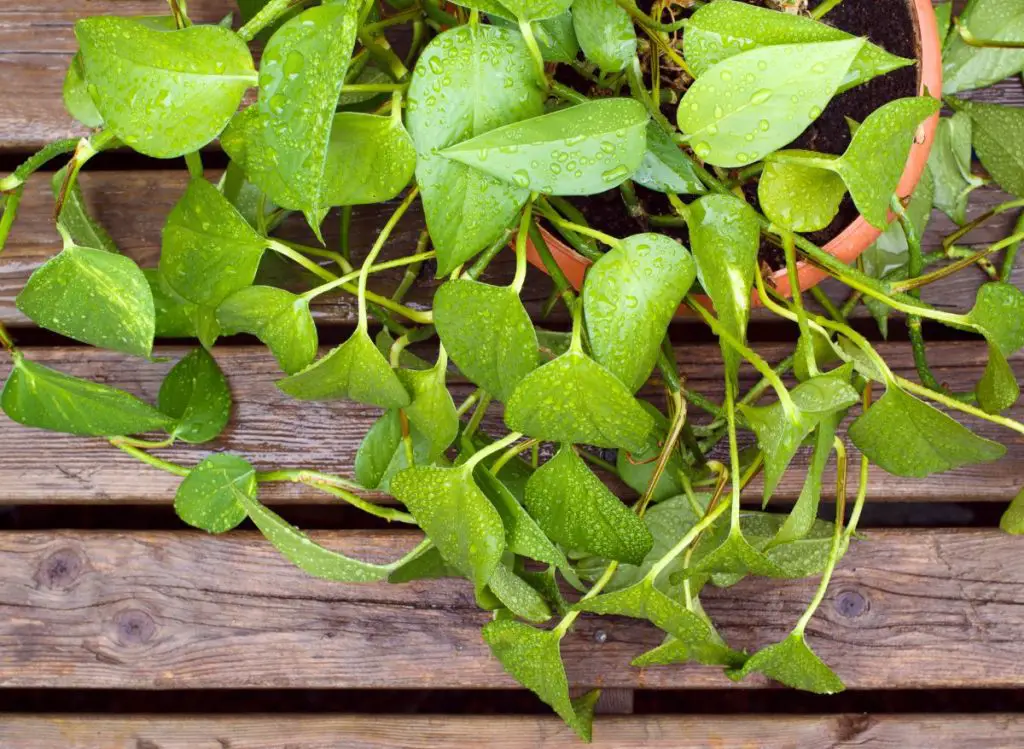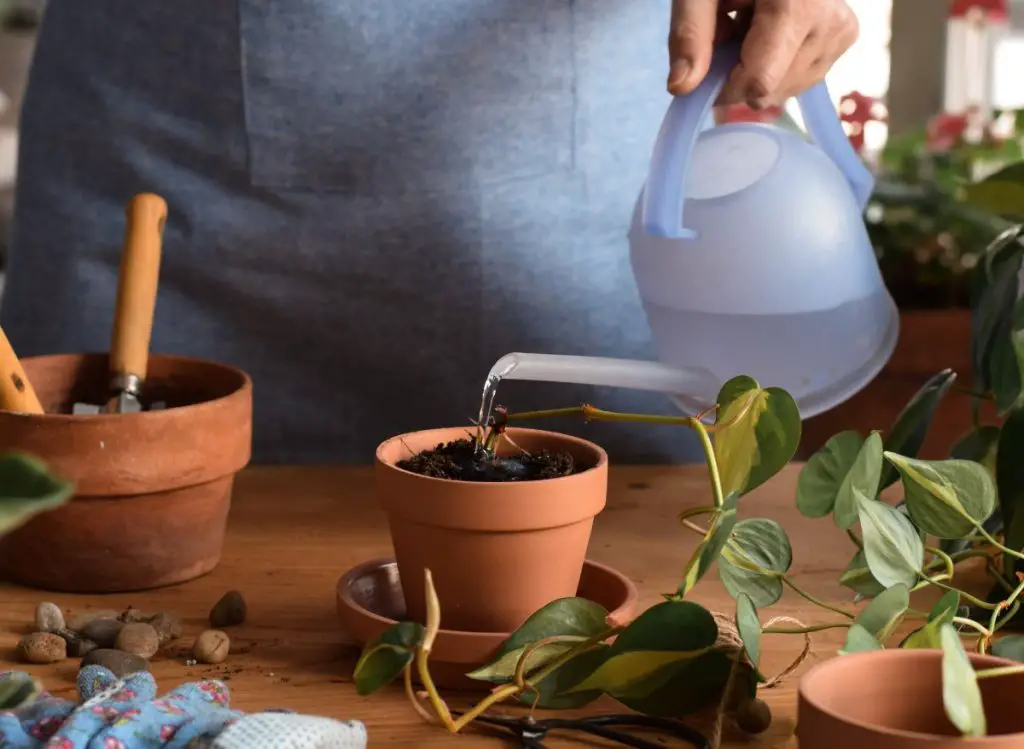Pothos plants, also called devil’s ivy or Epipremnum aureum, are among the most popular indoor plants because of their lush foliage and easygoing nature. But without proper care, pothos plants won’t thrive, and one of the most important parts of plant care is watering. So, how often to water pothos?
Generally, pothos plants should be watered every one to two weeks. A good rule of thumb for watering pothos is to feel their soil moisture. When the first inch to two inches (3 to 5 cm) of soil feels dry to the touch, it is time to water your pothos plant.
Read on to find out everything you need to know about how to properly care for pothos.
See also: 11 Top Peperomia Varieties To Add To Your Garden (With Characteristics of each!)

Factors Affecting Pothos Watering Needs
The watering frequency of any plant, including pothos, depends on the season and other conditions. Generally, the pothos plant feels changes in temperature, day length, and humidity; therefore, you must adjust your watering schedule.
Several factors affect pothos watering frequency, depending on the room’s temperature, plant size, humidity level, container’s size, and soil mixture.
The table below shows the main factors affecting pothos watering requirements.
| Fall And Winter Season | Pothos plants generally go dormant in late fall and early winter. During wintertime, water your pothos plants once every two weeks because of the lower amount of sunlight and heat they get. Always check the soil with your finger before watering to avoid overwatering your plant. It is essential that you keep your pothos plants away from cold windows or door breezes during wintertime to avoid damaging them. Whenever possible, use only lukewarm or room temperature water to water your plants to prevent a cold shock to the plant. |
| Spring Season | After waking up from long winter dormancy, pothos’ growing season gradually begins in spring. As your plant starts to wake up and takes in more water and nutrients, you must adjust your watering schedule. Generally, it is recommended to water pothos once a week in springtime, depending on the climate. – During March, water your plants once every two weeks. – Throughout April and May, steadily increase your watering frequency to once every 6 to 8 days. – June, water every four days |
| Summer Season | In Summertime, water your pothos plants 2 to 3 times a week during the warm days. Summer generally means hot temperatures, suggesting that you frequently water your plants to compensate for the quantity of water lost through evaporation. Pothos experience the most prolific growth phase in temperate climates, meaning they will need more water than during other seasons. Also, a hotter climate can lead to less humidity, which will result in more evaporation from your pothos plant. Before watering, check the soil by poking your finger or using a wooden stick. If you notice that the first couple of inches is dry, it indicates that it is time to rewater your plants. |
| Humidity Level | Pothos plants grow well in high humidity levels; however, they need water to get the required nutrients and stimulate growth. Pothos generally prefers a temperature of 80° Fareneith (26.7° Celsius) and a humidity level of about 70% or more. If you are having trouble boosting the humidity in your home, you can invest in a good plant humidifier. The humidity increases during the rainy summer days while the temperature drops. Generally, the humidity level in your home dictates how much water your pothos needs. Low humidity levels lead to increased evapotranspiration, damaging your pothos’ leaves. Pothos need humidity levels between 50% to thrive, preferably around 70%. |
| Temperature Levels | Pothos requires 70 and 90° Fareneith (21 and 32° Celsius) temperatures. You can water your plant once a week when the temperature is in this interval. Extreme temperatures (below 70° F and above 90° F) cause pothos’ roots to be permanently damaged. |
| Containers Requirements | Pothos grow well in many types of pots and containers with a drainage hole at the bottom as it will prevent the build-up of water and lowers the risk of overwatering. Ensure you choose an appropriate size for your pot or container. Your pothos will need water less often in plastic pots because plastic pots are not porous and will dry gradually. Earthenware or ceramic pots are a good choice for your pothos as they absorb water moderately faster; therefore, you will need to increase your plants’ watering frequency. Terracotta pots are the best choice for pothos plants because they are highly porous, and water will dry evenly and rapidly. You will need to increase your watering frequency. |
| Type of Soil | When choosing soil mixture, pick vermiculite to retain moisture for a more extended period. Vermiculite is a mineral mainly made to soak water like a sponge. It also helps slow water evaporation and maintains the soil at root-level moist. And remember to choose a soil mixture that drains water as pothos doesn’t like soggy roots properly. |
| Your Pothos Plant Size | How much water your pothos plant need also depends on its size. Smaller pothos plants typically don’t require as much watering as big ones. Big pothos plants require watering more often every five days in an optimal growth environment. If you find yourself watering pothos frequently, it might be time to switch to a new pot with a fresh soil mixture. |
Tips For Checking Pothos Moisture Levels
- To check if your pothos needs water, stick your finger 3 to 4” (8 to 10 cm) into the soil around the bottom of the plant.
- If your finger comes out predominantly clean and dry, it is time to water.
- But, if your finger comes out muddy, your pothos plant is likely feeling asphyxiated by overwatering or poorly drained soil.
- The best time to water your pothos plant is when the top 1 to 3” (3 to 8 cm) of the soil is almost completely dry (depending on its container or pot size).
- You might notice that your pothos plant may start to wilt a little bit, signaling that it is thirsty. Don’t worry; it is entirely normal.
How to Properly Water Pothos Plants?
- Non-chlorinated or filtered water is ideal for watering pothos plants because they can be sensitive to contaminants.
- Pothos plants prefer room temperature water.
- Always water your pothos from their base to avoid accumulating too much moisture on the leaves themselves.
- Watering your pothos from their base will help prevent any disease or fungal issues.
- Water your plant until it flows out the bottom drainage hole of the container. And as soon as the water comes out of your container’s drainage hole, stop watering and let the moisture thoroughly penetrate the soil.
- Ensure that water never floods or pools upon the soil’s top, which is a sign of poor drainage.
- If your pothos container doesn’t have a drainage hole, assessing the proper moisture level will be much more challenging.
- Use hanging baskets or clay pots with one or more bottom drainage holes to grow pothos plants.
- If the soil appears thoroughly moist, stop watering and watch your plant perk up within the next hour.
- If the soil appears a little dry, continue watering flush until it runs out of the pot or container’s drainage hole and stops watering.
See also: How To Properly Grow and Care For Olive Trees?

How to Determine If Your Pothos Plant Needs Watering?
The best and easy way to determine if your pothos plant needs watering is to look out for the early signs of dehydration and act fast.
1- Use a Finger Or a Stick To Test Moisture
Stick your finger or a wooden skewer and poke 1 to 2 inches (3 to 4 cm) into the soil to check its moisture.
If you feel it is dry, it is time for watering. However, if it is still moist, leave it be and recheck it the next day.
2- Look For Overwatering Signs
Signs of an overwatered Pothos include leaf browning, leaf yellowing, wilted pothos plant, root rot, and stunted growth. Pothos plant displays these signs when it tries to intake more water than it can process.
If you notice these symptoms, don’t water your pothos. Leave it dry for some time, remove the completely damaged leaves with gardening shears, and wait until your plant recovers.
3- Soil Color
Even though soil color will depend on several factors, including the amount of organic matter and mineral content.
The general rule is that the lighter the soil color, the drier the soil. According to the Food and Agriculture Organization (FAO):
- A brown color usually means that the soil has good natural drainage.
- And a black or dark grey color usually comes from accumulating organic matter.
4- Yellowing and Browning Leaves
Generally, yellowing and browning Leaves indicate overwatered pothos plants, which means that the leaves can’t get enough nutrients, resulting in yellow discolorations, browning edges, and leaves falling off.
The general advice is to repot your pothos plant into well-drained soil in a new pot and remove the damaged leaves after repotting.
5- Using A Moisture Meter
Moisture meters do not measure the amount of water in the soil but the conductivity. Low numbers typically indicate dry soil, and high numbers refer to overwatering.
Moisture meters are more suitable for beginner gardeners, particularly people who don’t have much time to care for their plants.
See also: How To Fix Watermelon Peperomia Drooping?
How Much Water Does Your Pothos Plant Need?
Pothos plant needs to be watered every 1 to 2 weeks to allow the soil to dry out between waterings. Increase water frequency in brighter light and lower watering frequency in lower light.
Your pothos plants will thrive when appropriately watered. A good rule to follow when watering is to poke your finger down in the soil.
| Signs That Your Pothos Plant Is Overwatered | Signs That Your Pothos Plant Is Underwatered |
| signs of Overwatered pothos include the following: – Curling leaves – Leaves feel and look mushy – Leaf browning – Leaf yellowing – Mold growth on soil – Wilted pothos plant – Root rot – Edema – Slower growth – Floppiness with stagnant shoots | signs of underwatered pothos include the following: – Leaves and vines look limp – Slow growth – Soil separates from the edge of the pot – Yellow leaves – Crispy leaves – Wilting foliage – Desert soil – Dry, dead leaf tips – Brown leaves |
Wrapping Up
Watering your pothos plants should be a rewarding activity for you and your pothos. For optimal results, pay extra attention to environmental factors, including seasons, humidity, temperature, type of soil, and the type of containers you are using to determine how much and how often you should water your pothos plant.
Often inspect your plant for signs of underwatering or overwatering.


